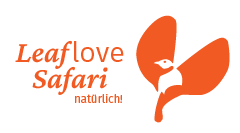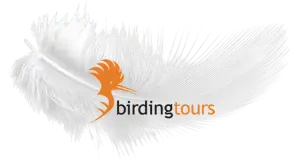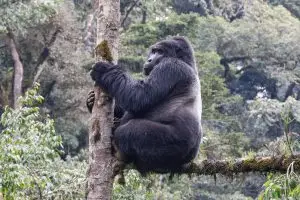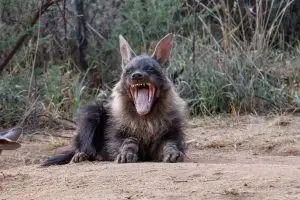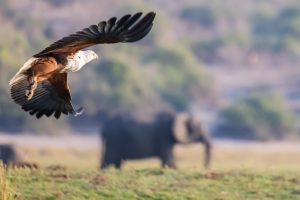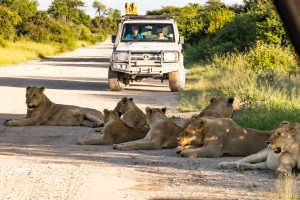17 Days - This fantastic professionally guided trip to Uganda...
ViewTravelogue - Avifauna Okavango 2022
Species-rich northern Namibia
- Home
- About us
- Travelogues
- Avifauna Okavango 2022
Travelogue of the species-rich birding tour Avifauna Okavango to north-eastern Namibia, which was conducted by Leaflove Safari for Birdingtours in November 2022
So that you have a safe holiday!
We departed from the capital at noon, setting our course northwest. Nausea was already settling in, knowing we were in for a lengthy journey. Claudia was visibly struggling with jet lag, and I doubted I could offer any satisfying roadside bird watching along the highway.
Our plan was to fulfill some desires at the Avis Conservation Area. To my dismay, upon arriving from the Swakopmund, a place known for its quality of life, we were met with the aftermath of a fire. The entire area was now dotted with bare, blackened trees and shrubs, standing like solemn tombstones across the landscape.
It became apparent to me that our next trip should commence from Walvis Bay. That way, clients could fly over Cape Town and indulge in some birding there as well.
Thankfully, I found the perfect alternative and drove to my friend Fritz’s place in Monte Christo, nestled below the Otjihavera Mountains. With almost 55 species spotted, the journey finally commenced, and everyone unanimously agreed that the Painted-snipe was the star of the show.
We were treated to a delightful sight of a flock of pelicans, nearly 50 white-backed vultures, a Striated heron, and the usual array of wading birds. Even I was exhilarated when the Ruppell’s parrots, their cheerful chatter unmistakable to those in the know, allowed themselves to be photographed trustingly and beautifully. Loudly, we marveled at the Violet wood hoopoe perched atop the winter thorn trees, and passionately debated the characteristics of the Damara red-billed hornbill. Relentlessly, the group fueled my enthusiasm from one species to another, and finally, after glimpsing a swallow-tailed bee-eater, I accelerated westward at full throttle.
Late and fatigued, with a barely visible birding list in hand under the dimming light, we managed to catch a sight of a Freckled nightjar and three others preying on insects. The sun set on our first night.
The Erongo was indeed breathtaking, especially with the colossal menhirs glowing vividly in the morning light. Before sunrise, we spotted Hartlaub’s Francolin and Rockrunner (Achaetops pycnopygius) through our binoculars. Even the customary call of the Pearl-spotted owlet garnered attention from the inhabitants of the acacia trees. The White-tailed shrike appeared en masse, and the Bicycle Pump (the Pririt batis) kept us all alert. The Klippschliefer also made a striking appearance.
After a sumptuous breakfast comprising a delightful vegetable omelette and exquisite blue cheese, we ventured to Didi’s farm, the Erongo Rocks. The scorching heat didn’t deter us, and after an extensive search, we finally located the elusive Layard’s warbler, finding solace in the shade of the climbing figs as we had suspected. Continuing north with the aid of air conditioning, we encountered the Monteiro’s hornbill, a regal rock eagle perched high in a cave, and the resplendent Green-winged pytilia. With contentment settling in, everyone relaxed a bit during the long drive. At the Swiss woman’s place, her dark complexion a surprise given her accent to most, we savored delicious cheesecake with cappuccinos, followed by thunderstorms, glider watching, and our arrival in Etosha.
We brought along breakfast packs and reached the Andersson Gate of the Etosha Park before daybreak. Our primary goal was to spot the Pink-billed lark, which proved to be a challenging endeavor amidst the vast salsola plains. Eventually, among Chestnut-backed sparrow-larks and several grey-backed larks, we spotted the coveted species, some of them graciously posing on small limestone formations for our cameras. The group delighted in the lively chirping of the Spike-heeled Lark.
Although feeding animals in the park was strictly prohibited, Brigitte couldn’t resist offering a generous sultana to a ground squirrel that approached her during our breakfast picnic. She remarked that she had never been fond of sultanas, granting the fortunate squirrel an unexpected treat.
The Pygmy falcon made an appearance, its tail elegantly arched in the rain, and everyone was in awe of its display. We paused near a herd of zebras when a Marsh Owl gracefully swooped in, choosing to perch amidst the scorching, open savannah. Flitting to and fro, we indulged in capturing numerous photographs of this rarely seen marvel. Our luck seemed boundless.
In Halali, we observed the obligatory Bare-cheeked Babbler nestled among the now luxuriant green mopane trees. A lively group of Helmetshrike drew our attention, adorned in their striking plumage. With a Magnum ice cream in one hand and binoculars in the other, we playfully acknowledged the strenuous yet fulfilling journey. Burchell’s courser sightings are relatively rare, and our delight was evident when we managed to catch a glimpse of these delicately patterned, swift-footed birds, often darting into the distance. This joy multiplied as we stumbled upon several groups and, “finally,” had the opportunity to marvel at the typically common Double-banded courser.
Certain sightings cannot be guaranteed as a tour operator, yet Africa has its moments of generosity! One such moment unfolded before us, a cheetah sighting atop a four-meter-high termite mound against a strikingly dark background in the perfect light.
Initially, we spotted them resting under a tree, which was a marvel in itself. But then, as if performing for an audience, the cheetahs rose and dashed across our path, heading straight for a herd of zebras and wildebeest. Dark clouds loomed behind the herd, creating a dramatic backdrop as the golden sunlight bathed the cheetahs in a mesmerizing glow. It was an extraordinary sight, almost surreal, and we were there to witness it!
The cheetahs soon embarked on a hunting expedition, but as the day drew to a close, we reluctantly bid farewell to the park. In jest, we pondered who would choose bird-watching over the thrill of spotting cheetahs, only to be interrupted by another intriguing bird sighting in the distance.
At Mushara, our dinner was a delightful affair, evidenced by the empty plates that were perhaps the highest compliment to the kitchen.
The early morning walk treated us to the musical calls of Crested Francolin, Swainson’s spurfowl, and numerous Bushveld Birds, all raising a ruckus over the presence of a Pearl-spotted owlet in the tamboti trees of this arid forest.
At 8:00 am, an early ornithological spectacle unfolded. I nearly overlooked the Bronze-winged courser, mistaking it for a Crowned Lapwing, until its distinct head prompted me to take a closer look in reverse gear. Unfortunately, our joy was short-lived as the elusive nocturnal bird chose to retreat into the grass and evade our further observation.
In Namutoni camp, we chanced upon a small wedding. A Blue waxbill plucked a leaf and performed a dance for its mate, reminiscent of the headbanging era of the ’90s. It remained unclear whether the bride was truly impressed, as she flew off nonchalantly, searching for seeds on the ground.
Our journey to Andoni was punctuated by several stops at waterholes and artesian springs north of Etosha, revealing a multitude of shorebirds and an impressive gathering of 14 Blue cranes at the stunning King Nehale Lodge. We also managed to add the fifth Painted-snipe to our list, along with a Whiskered tern and another grey-headed gull. This area proved to be a paradise for pipits and cisticolas, with hundreds of African pipits, a few Plain-backed pipits, and Buffy pipits alongside the Kweck’s Grass. The incessant chirping of the Desert cisticola and sightings of the Zitting Cisticola in the wetter regions further enhanced our ornithological adventure.
The lodge was a sight to behold, and despite our limited time, everyone made use of the private pools in their rooms. The food was nothing short of exquisite, and I even had some Swedish bitters on hand to savor the experience fully.
On our drive day to the Okavango at Rundu, we were greeted by four Temminck’s coursers standing by the roadside as if they were our welcoming committee. The garden was delightfully shady, allowing us to enjoy a leisurely stroll. We captured some beautiful moments with a Eurasian hoopoe and a Fork-tailed drongo feeding at their nest, which Martin casually pointed out to us. The white-browed tit-warbler lived up to its name with a powerful song, adding to the tranquil ambiance. Openbill storks and Blue-cheeked bee-eaters stirred just as much excitement as the adorable Red-billed firefinch, which appeared as if its creator had recently dipped it in a pot of red paint.
As the sun set on the Okavango, some preferred a Rock shandy while others leaned toward the sweet Malawi shandy. We hastily made a list of sightings, everyone tired from the day’s adventures. I was almost half dead, quickly finishing my meal before heading to bed, knowing we had an early start at 6 a.m. with not much time to spare.
Our day started with our usual late breakfast. The sound of “Piet my vrou” “Piet my vrou” from Angola filled the air, which we learned was the Red-chested cuckoo’s call in the Afrikaans language. Playing the sound loudly, we were greeted by the cuckoo flying over the Okavango, calling loudly to us and delighting the entire group.
Breakfast brought new bird species such as the Black crake, Coppery-tailed coucal, Jacobin Cuckoo, and White-bellied sunbird, adding to the excitement around the breakfast table and enriching our birding experience.
In the garden, Claudia, with her sharp eyes, discovered the nest of an African hoopoe. We all gathered on the lawn, crouching down to photograph the fly-ins without disturbing the hoopoe. Some self-drivers observed us and, unfortunately, inspected the nest more closely after we had left, much to the frustration of our conservation-minded guide, Dirks, who did not condone such behavior.
While observing mating birds, Brigitte humorously remarked, “So they won’t become extinct for the time being.”
The monotonous black road quickly passed by, accompanied by the usual seasonal parasites and black kites. Insider topics enlivened our journey, and before we knew it, our destination was within sight.
Enthusiasm was slow to build at Ngepi Camp. It was apparent that the management was more concerned about their own interests than the welfare of their guests. However, we still found joy in experiencing nature up close, even if it was an unconventional experience.
Our mood improved during the boat ride, with the love for nature clearly visible on the faces hidden behind binoculars. The sun painted the sky in glorious hues as hippos snorted loudly nearby. A fantastic sighting of the White-backed night heron, a shy nocturnal bird, rounded off the trip perfectly. We spotted two oxpecker species on hippos, the Retz’s helmetshrike in the water pear Syzygium guineense, and the majestic Goliath heron strutting along the grassy bank. The Pied and Giant kingfishers made our cameras glow as they usually did, and then, after many more sightings to add to our list, the hammerhead flew up, bringing us immense joy.
Dinner was enjoyed wearily, and for those interested, locally prepared mahangopap, a millet porridge, was served to accompany the meat. Fortunately, there were alternatives for those who didn’t appreciate it, although some seemed to enjoy it.
The next day, we set out early to explore a small patch of forest, likely the last spared one on the Rundu-Divundu route, in search of rare species. The heat drove us back to the lodge after a delightful Klaas’s Cuckoo observation.
In the afternoon, we ventured to Mahango Park, where a host of animals awaited our gaze. Young impalas, warthogs, kudus, lyre antelopes, countless lechwes, reedbuck, and buffaloes were our targets for the day. Bateleurs and African fish eagles were seen up close, adding to the excitement of the day’s birding. We expanded our list of babblers and Brigitte remained hopeful for the Black crowned crane, although the sight of the Wattled cranes was more than enough for our enjoyment.
After dinner, we returned to owl-watching. The barn owl soared directly above us in flight, while the African Scops Owl continued its “brut brut brut” even in the spotlight. A few pictures later, we retired for the night, content with the day’s experiences.
The stormy night made for little sleep, prompting us to consider removing this particular accommodation from our itinerary. While we initially aimed for a mix of different lodgings and a closer connection to nature, the lodge offered too little comfort for some participants, and the completely open ambiance of the rooms was a bit too much. The manager, who called himself Rudi Perplexed, was somewhat overwhelmed by the task of hosting guests. Despite this, everyone remained positive and continued birding with a smile. We made a note to exchange this accommodation for a better one in the future.
The border crossing was pleasantly smooth. The bird-rich garden of Drotskys Cabins and the friendly owner worked wonders, and the sighting of the Narina Trogon by good Otto made for an ornithological spectacle. A brief respite by the paradisiacal pool put everyone in the best birding mood. Narina Trogon—could it get any better than this?
The bird feeder at the lodge attracted an array of species, including the Fan-tailed widowbird and Southern brown-throated weaver. Beautiful Southern double-collared sunbirds displayed their shiny green backs among the yellow flowers.
Our boat trip yielded many new species, although we were initially searching for the Pel’s fishing owl. Hadada ibises with their nest and three chicks, skimmers, ospreys, African fish eagles, and various swallows graced our journey. We planned to continue our search the next morning.
In the evening, Piet treated us to a view of the Mohol bushbaby in the garden, charming us all with its cuteness.
Early the next morning, the cook rushed to inform us that we were expected at Campsite 17. Despite the sweat-inducing trek at 6 a.m., we all held onto the hope of a remarkable sighting. Otto transformed this hope into pure joy by pointing out the Pel’s fishing owl perched atop a tall jackalberry tree. Its golden yellow plumage and distinct black spots made for a memorable sight. The owl soon took flight, but we managed to capture some photos as it settled in another tree. It was a truly wonderful experience.
We also spotted two more Narina Trogons before meeting for breakfast. The group was reluctant to leave, wishing they could stay longer to enjoy a holiday dedicated to birdwatching. But we pressed on, and soon the sight of the Broad-billed roller captured our attention, allowing us to make some good observations from a distance.
The return border check revealed sightings of an Icterine warbler, Brown snake eagle, and martial eagle in flight.
Despite the downpour during our journey, the boat trip on the Kwando brought us joy with sightings of the African green pigeon, Purple herons, and a Grey-headed kingfisher. Although the weather turned chilly and windy, a comforting gin and tonic helped lift our spirits momentarily.
After a satisfying breakfast, we set off for the Kwando Core Area of the Bwabwata Park. At the entrance, we were delighted by the stunning Red-headed weaver with its female and several Retz’s helmetshrikes. The dense teak forest granted us the sought-after success of finding the Racket-tailed roller. This rare bird was a real gem for the birding community, leaving us feeling proud as our group had seen Pel’s fishing owl, Narina Trogon, White-backed Vulture, and now the Racket-tailed roller within a few days.
A Wahlberg’s eagle swiftly maneuvered through the trees, while a Lesser spotted eagle perched atop a bare tree, as if posing for a photoshoot. White-headed vultures mingled with White-backed vultures and Lappet-faced vultures, and a Striped kingfisher rounded off our satisfying list. Satisfied, we returned for lunch.
In the afternoon, we enjoyed a game drive in an open vehicle with Aldrin, a local guide, who was enthusiastic about introducing us to the local wildlife. Despite some minor prioritization challenges with bird viewing, we managed to spot some exciting species, including the Tinkling cisticola and Pin-tailed whydah, making it an enjoyable experience for all.
After dinner, we were treated to the sight of two African wood owls. One of them showcased its grace silently, while the other continued calling into the spotlight.
“I cleaned my binoculars and suddenly there was no more fog,” I joked in the morning, lightening the mood. We all laughed heartily and teasingly pulled Brigitte’s leg. It was bound to be a great day.
The morning hike proved to be somewhat uneventful, but we managed to spot a Thick-billed weaver and some of the usual “we’ve seen that before” birds. Breakfast was a welcome respite for everyone.
Our journey continued straight to Kasane, where we were blessed with the sighting of the African golden oriole in a patch of forest, despite the scorching heat. Steppe eagles circled high above, while a Willow warbler remained busy peeping through the leaves.
Following the customary delays at the border, we ventured back into Namibia by boat via Botswana, enjoying the individual attention of the well-known Peter Visagie. The Visagie family had been a prominent fixture in the Zambezi and Chobe regions for generations. Peter, the owner of Zovu Lodge, personally guided us through the waters, demonstrating his skill at navigating the boat and providing us with numerous bird-watching opportunities.
The birding at the Falls was exceptional, with the Shalow’s Turaco making an early appearance, courtesy of a friendly Englishman. Bearded scrub robins, Neddickys, Red-winged Starlings, Tropical boubous, Hooded Vultures, and many other species delighted us as we ventured through the dense, lush spray forest near the impressive falls. The cappuccino at the cafe was the best of the entire trip, leaving us fully satisfied before we departed after visiting the Batoka Gorge.
I bought Barbara a cappuccino, which she enjoyed with a “short” Amarula. Although one would expect a female driver to forgo such indulgences, it was gone in a flash. It made me wonder if the cappuccino was just as good.
Peter welcomed us back on time, and as the boat pulled up to the familiar jetty, Flecki the Jack Russell jumped aboard to greet his master. It almost felt like coming home, as Zovu Lodge truly was a “home away from home.”
Our birding list continued to fill up, and almost everyone had registered with Ebird for online maintenance and tracking.
At the border, we noticed a mango tree where we spotted a Red-faced mousebird, a Black-collared barbet, and even a Smith’s Bush Squirrel feasting on ripe mangoes. To my amazement, we even saw two more Collared palm thrushes at a bus stop and at the border. Although it’s usually scarce, the bird seemed to reveal itself as a special treat for us.
Our journey back to Namibia was rewarded with a visit to the breeding colony of Carmine Bee-eaters. Curti, a friend of mine and a renowned birder, guided us through the floodplain. Although I initially struggled to find my bearings, a Sheep’s Wagtail in the cattle kraal lifted my spirits. We were treated to a sight of hundreds of crimson finches in the midst of the field, capturing moments of nature at its finest. A booted eagle engaged in aerial maneuvers, continuously fending off attacks from yellow-billed kites.
The boat trip from Mubala Camp, nestled between tall trees, was peaceful and successful. We managed to spot the elusive Slaty Egret from afar, observing its shy yet graceful presence.
Curti lent us his expertise, spending the entire morning with us in a selfless act of support, despite having his own guests to attend to. We were guided to a dense riparian forest of the Zambezi, where we discovered the Yellow-throated Leaflove. This rare species was a super find, considering its recent discovery in southern Africa and the limited number of individuals in the entire region.
We continued our adventure, eventually stopping by a body of water where several African Pygmy Geese were swimming amidst dense water lilies. We marveled at the African jacanas and enjoyed the sight of an Eastern nicator flitting through the swamp landscape.
The boat trip in the late afternoon provided more excitement, with the Northern carmine bee-eaters stealing the show. The Heliornithidae also made an appearance, creating a stir of excitement on the boat. It was the perfect end to our journey, leaving us with a sense of peace and contentment.
As we prepared to depart on our last evening, we reflected on the journey, enjoying a refreshing selection of beer, rock shandy, and gin and tonic. With smiles on our faces, we bid each other farewell, already looking forward to the next adventure.
This might also interest you:
Wildlife B5 – slow & natural (en) – May & June 2025
16 Days, 27.5. - 11.6.2025 - Guided nature safari with...
View